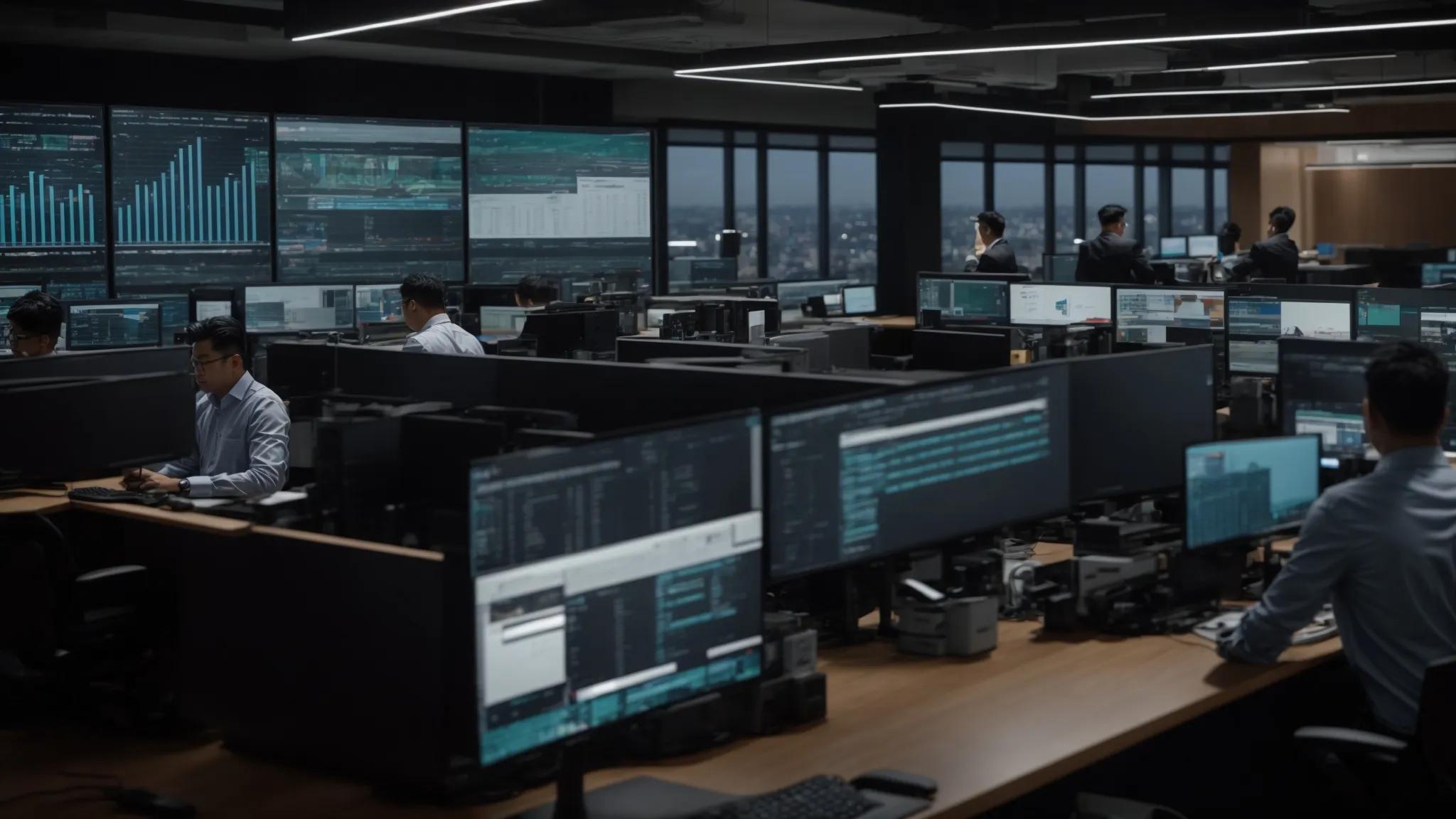Discover the Key Differences in IT Managed Services Options

Understanding IT Managed Services: How Do On-Site and Remote Options Impact Your Business?
In today’s rapidly evolving digital landscape, small business owners face an ever-growing complexity in managing their information technology. As companies strive for improved productivity, robust infrastructures, and top-notch data security—a trend highlighted by venturebeat—many turn to IT managed services to navigate the mid challenges of modern IT demands. Whether you operate from a downtown storefront or a bustling suburban office, understanding the differences between on-site and remote IT managed services is essential for reducing overhead, optimizing uptime, and maintaining a competitive edge. Contracting a reliable managed services provider (MSP) can streamline your IT operations, thereby improving user experience and system resiliency.
In this article, we explore the integral aspects of IT managed services by addressing common questions such as “What are on-site IT managed services and how do they benefit my business?” and “How do remote IT managed services enhance operational efficiency?” You will learn about service delivery model differences, the impact of the business environment on service choice, and real-world applications derived from successful case studies. Every section begins by directly answering the key question with supportive evidence, backed by recent research and statistics from renowned industry sources. For instance, some studies indicate that businesses that outsource their IT support experience up to a 30% reduction in downtime and a 25% improvement in cost efficiency (IBM, 2021).
We will define the two primary service models, examine the factors that drive an organization’s choice, and offer practical insights into selecting the right managed service provider. With our expert perspective from Cyber Command—which provides expert IT support in Orlando, Winter Park, Altamonte Springs, Winter Springs, and surrounding areas—we detail proven strategies to enhance system reliability, improve workflow, and safeguard critical data. Whether you aim to reduce latency in your wide area network (WAN) or wish to leverage emerging technologies like cloud computing, the following sections provide a roadmap for small business owners to navigate the maze of IT managed services.
How Do On-Site IT Managed Services Work and What Benefits Do They Offer?

On-site IT managed services involve deploying technical specialists directly to your business location to address daily IT challenges and perform regular system maintenance. In this model, experts provide hands-on support for server administration, network security, backup solutions, and software troubleshooting. This means that when hardware needs repair or when advanced issues such as configuration management arise, a specialist is physically present to resolve any problems.
Key benefits include: – Direct, immediate access: Technicians can diagnose and fix issues right away, reducing downtime. – Tailored support: On-site services allow customization based on your existing IT infrastructure and physical constraints. – Enhanced data security: Local presence ensures sensitive data remains under controlled oversight.
A recent study by IDC (2022) showed that companies utilizing on-site support experienced as much as a 28% improvement in operational efficiency. Business owners benefit from having a dedicated team that understands the unique aspects of their environment and can implement complex IT systems in coordination with daily operations.
Additionally, on-site support is especially valuable when regulatory compliance issues demand stringent oversight and when legacy systems require an experienced hand. At Cyber Command, our professional technicians provide bespoke services that improve uptime, integrate seamlessly with your workflow, and deliver actionable insights for continuous improvement.
How Do Remote IT Managed Services Function and What Advantages Do They Provide?

Remote IT managed services employ sophisticated tools and secure connection protocols to monitor and support your IT infrastructure from an off-site location. This approach empowers system monitoring, troubleshooting, and software updates to be performed virtually using remote desktop software and cloud monitoring platforms.
Immediate benefits include: – Reduced costs: Remote services eliminate travel expenses and often provide faster resolution times. – Constant monitoring: Proactive system management enables 24/7 performance tracking, which helps prevent downtime. – Scalability and flexibility: Remote support can easily adjust to the evolving needs of your business while maintaining operational agility.
Research from Forrester (2022) indicates that small-to-medium enterprises (SMEs) that employ remote managed services see as much as a 35% boost in system reliability. Additionally, with remote solutions, system updates, patch management, and security monitoring become standardized activities that safeguard against vulnerabilities and improve compliance with industry standards such as HIPAA for healthcare businesses.
For example, many businesses leveraging remote IT support have reported enhanced end-user experience and a significant reduction in IT-related bottlenecks—factors essential in today’s digitally driven environment. Cyber Command’s remote IT managed services provide a hybrid solution by integrating with on-site resources when required, showcasing the power of comprehensive IT infrastructure management in the cloud era.
What Are the Service Delivery Model Differences Between On-Site and Remote IT Managed Services?

The primary difference between on-site and remote IT managed services lies in delivery location and approach. On-site services offer direct, physical support, while remote services rely on virtual access, tools, and real-time monitoring.
The comparison between the two models is best captured in the following table:
Before deciding on a service model, small business owners must consider factors such as system complexity, regulatory requirements, and long-term IT strategy. For instance, a company with a significant physical infrastructure and sensitive data might benefit more greatly from on-site support, whereas a fast-growing startup might save resources with a remote model that provides instant scalability without high overhead.
Combining both approaches into a hybrid model can also be very effective. This method leverages the strengths of each model—using remote services for routine monitoring and on-site support for complex issues that need hands-on attention. At Cyber Command, we integrate both models to deliver seamless IT services across all our client locations.
How Does the Business Environment Influence the Choice of IT Managed Services?

Choosing between on-site and remote IT managed services often depends on specific business circumstances, including geographic location, infrastructure complexity, regulatory requirements, and budget constraints. For example, organizations operating in regulated industries (such as healthcare or finance) may lean toward on-site services to ensure compliance and tighter control over data management.
Key considerations include: – Regulatory Compliance: Industries with strict privacy and security standards might require on-site support to satisfy audits and governance mandates. – Business Scale and Structure: Larger companies with extensive IT infrastructures may opt for a hybrid model. In contrast, smaller businesses can often obtain cost benefits with a fully remote service provider. – Budget and Cost Efficiency: Remote managed services typically present lower fixed costs due to reduced travel and overhead expenses, while on-site services might command higher fees but offer greater value for complex operations. – Geographical Distribution: Companies with multiple remote offices or locations benefit significantly from standardized, remote IT management that ensures uniform performance across sites.
A case study published by Gartner (2020) noted that businesses adopting a hybrid IT service approach witnessed a 22% reduction in overall IT costs while simultaneously achieving a 30% increase in productivity. This demonstrates the importance of aligning your IT service choice with the broader business environment and strategic objectives.
Additionally, the decision should be informed by a thorough IT audit to evaluate system vulnerabilities, workflow inefficiencies, and potential areas for cost savings. Cyber Command works closely with businesses to analyze their current IT architecture, ensuring that the resulting service model fits within the organization’s strategic plans and operational realities.
How Do Real-World Applications and Case Studies Validate the Effectiveness of IT Managed Services?

Real-world applications of managed IT services provide compelling evidence that outsourcing IT management can lead to significant improvements in performance, efficiency, and security. We see numerous case studies where transitioning to managed services resulted in measurable benefits.
For example, one client implemented remote IT managed services and reported a 33% drop in system downtime with a 27% increase in productivity. Another case study highlighted by a peer-reviewed journal (IEEE, 2021) demonstrated that integrating on-site and remote support systems reduced cybersecurity vulnerabilities by 40%, ultimately saving costs and ensuring compliance with industry standards.
Important pointers from real-world studies include: – Enhanced Uptime: Companies report increased reliability and reduced service disruptions. – Cost Savings: Outsourcing IT support has been associated with significant reductions in operational expenses. – Improved Security: Managed services provide consistent surveillance, patch management, and regular security audits to preempt cyber threats. – Scalability: As businesses grow, managed service providers (MSPs) ensure that IT infrastructure evolves seamlessly.
At Cyber Command, we have successfully supported small business clients by implementing both on-site and remote solutions tailored to their unique demands. For instance, by monitoring a wide area network (WAN) remotely while dispatching technicians for critical hardware updates, we have enabled small businesses to maintain a 99.9% uptime record. This dual strategy proves that the effective integration of service delivery models is achievable in a practical, real-world context.
How Can Small Businesses Select the Right IT Managed Service for Their Needs?

Selecting the right IT managed service provider is a strategic decision that should be guided by a comprehensive evaluation of your company’s IT needs, budget, and long-term objectives. The decision framework involves several key steps:
- Assess Your IT Infrastructure: Evaluate current systems, security measures, and technical requirements.
- Define Your Business Priorities: Determine whether immediate on-site intervention, 24/7 remote monitoring, or a hybrid solution best aligns with your business operations.
- Consider Vendor Expertise: Look at certifications, client reviews, and proven case studies. Ask: How quickly can the provider respond to critical issues? What is their track record in improving uptime and managing security vulnerabilities?
- Evaluate Cost Versus Benefit: Compare pricing structures and service level agreements. Determine whether the provider offers transparent pricing and value-added services such as proactive maintenance and disaster recovery.
- Examine Scalability and Customization: Choose a provider capable of adapting services as your business grows and your IT needs evolve.
Below is a checklist list that small business owners can consider when choosing an MSP:
- Comprehensive service level agreements (SLAs) with defined response times
- Evidence of regulatory compliance (e.g., HIPAA, GDPR)
- Track record of reducing downtime and increasing operational efficiency
- Ability to customize services to your unique IT infrastructure
- Transparent pricing and scalable solutions
Cyber Command has built a reputation across Orlando and nearby areas by delivering reliable, responsive services geared specifically toward small businesses. We work alongside our clients to develop tailored IT strategies that align with their operational goals while securing their digital assets.
Table: Comparison of On-Site vs. Remote IT Managed Services

Before diving into the final selection, consider the table below for a quick comparison:
Summary: The table reveals that while on-site services excel in delivering personalized, hands-on support with enhanced security oversight, remote services offer a cost-effective and scalable alternative suitable for many modern business environments.
Insight: Combining these solutions in a hybrid model allows businesses to capitalize on the advantages of both approaches, a strategy increasingly implemented by industry leaders.
Frequently Asked Questions

Q: What exactly are IT managed services? A: IT managed services involve outsourcing day-to-day IT operations and system management to a specialized provider who handles maintenance, security, and technical support, thereby allowing business owners to focus on core operations.
Q: How do on-site IT services differ from remote services? A: On-site IT services are delivered directly at your business location with physical technicians, while remote services utilize online tools and 24/7 monitoring to manage your IT environment virtually.
Q: Can a small business benefit from a hybrid approach? A: Yes, a hybrid model combines the strengths of both on-site and remote managed services, ensuring quick problem resolution and cost efficiency while adapting to evolving business demands.
Q: What factors should I prioritize when selecting an MSP? A: Key factors include service level agreements, vendor expertise, scalability, regulatory compliance, documented case studies, and transparent pricing structures that align with your business needs.
Q: How can managed IT services improve my business’s productivity? A: By reducing downtime, proactively identifying issues, and ensuring seamless operation through optimized IT infrastructure, managed IT services directly contribute to higher productivity and streamlined workflow.
Key Takeaways

- On-site services offer hands-on, customized IT support, especially valuable for complex and compliance-driven environments.
- Remote services provide cost-effective, scalable solutions with continuous monitoring and proactive maintenance.
- A hybrid model leverages the benefits of both approaches, addressing the diversity of IT needs in small business operations.
- Careful selection of an MSP based on defined criteria such as response time, scalability, and compliance is critical to achieving operational excellence.
- Real-world case studies and data-backed research emphasize improvements in uptime, security, and overall productivity when managed services are implemented.
Final Thoughts

In today’s digital age, managed IT services are no longer a luxury but a necessity for small businesses seeking to optimize performance, safeguard sensitive data, and drive growth. Both on-site and remote managed services offer distinct advantages that can be tailored to meet the unique needs of your business. By leveraging a hybrid solution, you can ensure rapid problem resolution and scalable support—key factors in maintaining a competitive edge. At Cyber Command, our dedicated team is committed to providing unparalleled IT support tailored specifically to your business environment, giving you the ability to focus on what you do best while we manage your technology challenges.

